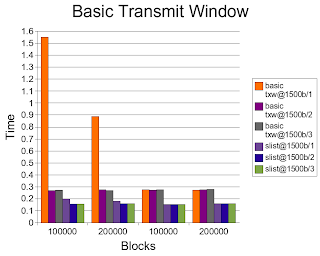So the results tell that a combination of containers is going to be useful, we can use a pre-allocated pointer array to store the details about each entry in the transmit window to gain the best access speed, and a trash stack based pointer system for the actual payload.
Its probable performance might be boosted further by using chunks of page size aligned data and sharing between several entries in the window. In so doing the overhead of generating or checking time stamps when inserting or purging from the window can be reduced. In this current stage of development we are I/O bound not CPU bound and so we shall revisit later when there is a greater surrounding framework, and burden on CPU that can highlight the difference.
The trash stack keeps freed packets and payloads allocated to the process for future use, a first in last out policy makes it cache friendly too. One important side effect is that memory stays in the transmit window system once allocated and will be unavailable to the application, but that is part of the rational of choosing the maximum transmit window size, either in bytes, sequence numbers, or time duration. Returning memory to the slice allocator would still keep the memory allocated to the process for application use but previous tests have shown at a latency cost. Using the system malloc instead of the slice allocator would be even slower but on Linux allow the memory to return to the operating system, however not all systems are the same, for example Solaris malloc never frees memory from the application.
Here you can see the implementation txw.c is slower than a basic singly linked list, this appears the overhead of using a pointer buffer instead of byte buffer for the packet details. To test this we compare the pointer buffer implementation with a byte buffer (txw-byte.c), and a byte buffer with pointer index (txw-bytep.c) in case the multiply is slow.
The results show that in fact the pointer array implementation is faster than a byte array.
Wednesday, 11 April 2007
Subscribe to:
Post Comments (Atom)



No comments:
Post a Comment